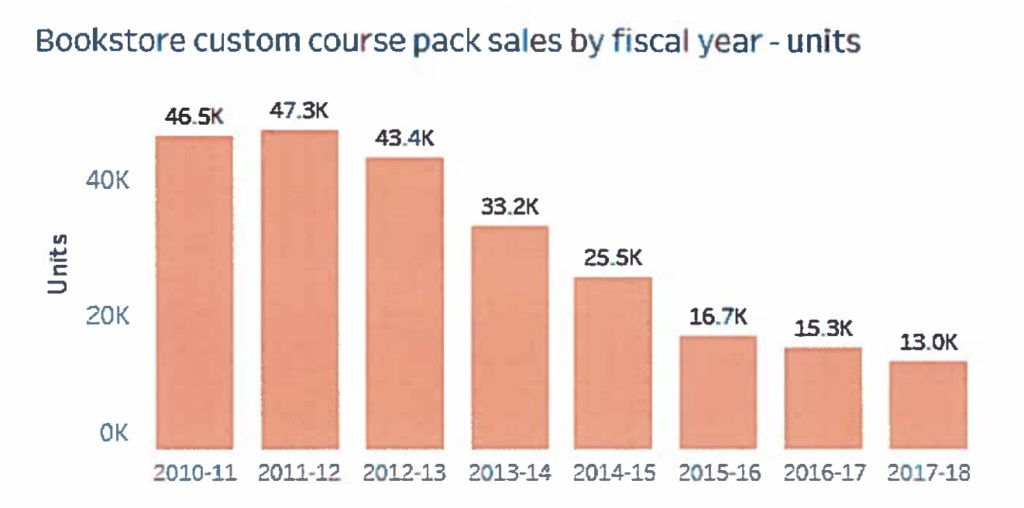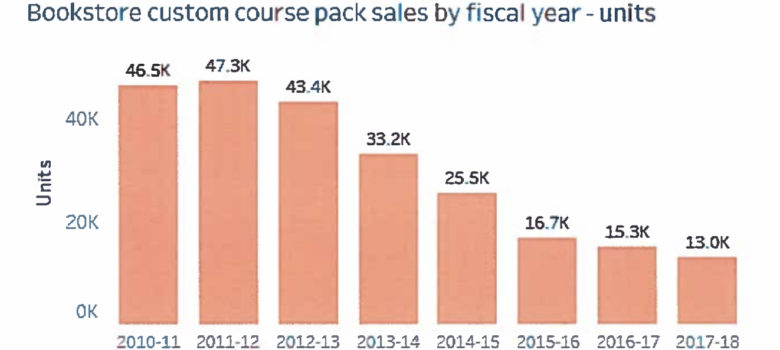The changing state of course materials in education involves more than just increased reliance on alternative materials such as journal and newspaper articles. Yesterday’s post highlighted the significant decline in book copying as part of coursepack materials, but the data also consistently demonstrates that coursepacks are being abandoned in favour of digital course management systems (CMS) (previous posts in the misleading on fair dealing series on the impact of the 2012 reforms, the wildly exaggerated suggestion of 600 million uncompensated copies each year, and the decline of books in coursepacks).
The emergence of CMS as the dominant form of materials distribution has a profound impact on the Access Copyright licence. While the copyright collective is quick to argue that its licence covers both print and digital uses, the shift to CMS means that educational institutions can more easily rely on alternative site licenses, open access materials, and links to third party content as major sources of course content. This increases the relative value of alternative licences (such as site licensing of e-books, journals, and newspapers), which, unlike the Access Copyright licence that is limited to reproduction, can be used to provide both access to the materials and their reproduction. It also means there is a reduction in overall copying as students no longer receive copies of all works, instead accessing the materials posted online.
The increasing shift away from coursepacks to digital CMS is easily demonstrated by the data before the Copyright Board and copyright review committee. For example, Access Copyright admitted it believes that is happening in response to a question from the Copyright Board in 2016 (Document AC-18):
Q. Please comment on the following hypothesis: The data show that paper coursepacks are being progressively replaced by digital CMS.
A. Access Copyright agrees with the hypothesis. Overall coursepack reporting peaked in 2006 and has gradually declined over time (see Exhibit AC-5, Table 3.3 at p. 11), but the question of whether paper coursepacks are being progressively replaced by digital CMS is unclear. Access Copyright believes it to be so and has been insistent that any new licence with post-secondary educational institutions must include digital uses; however, it is not possible to demonstrate a displacement of copying from coursepack to CMS use because Access Copyright has no time-series data documenting the evolution of digital CMS use.
While Access Copyright says it does not have definitive data to demonstrate the CMS use, there is plenty of data that confirms the shift. In fact, Access Copyright commissioned a study on copying practices at Canadian colleges as part of its ongoing case at the Copyright Board of Canada on post-secondary copying practices (Document AC-4) which found that 55.1 per cent of the volume of copying was done for posting on a CMS, 10.2 per cent for coursepacks, 26.6 per cent for handouts in class, and 7.9 per cent through hyperlinking. Similarly, the report Access Copyright commissioned for the York University litigation concluded:
a comparison of the volume of print copying versus digital copying for the period for which there are comparative data (2011-2013), the copying behaviour at York appears to be shifting from the inclusion of published works in print coursepacks to the posting and copying of those works on an LMS system.
Data submitted to the copyright review affirms that the shift is replicated at universities across the country. The University of Calgary reported to the committee:
To keep course materials affordable, instructors are using material licensed and paid for by the library (e.g. e-journal articles and eBooks) rather than custom course packs or expensive textbooks. Indeed, the use of course packs has decreased as the availability of licensed digital resources has increased. While 118 courses used course packs in the 2013-14 school year, in 2016/17 only 85 courses used them. In 2017/18, approximately 53 courses used course packs.
For a university of 30,000 students to use only 53 coursepacks demonstrates how printed materials are largely disappearing from many university campuses. In fact, at the University of Calgary there are 27 courses using freely available open access as the primary text, pointing to a near future where freely available materials surpass printed coursepacks.
There is similar data at other universities. The University of Winnipeg submitted to the committee that this year over 1,600 courses have been created in its CMS, a 50 per cent increase since 2013-14. Meanwhile, Allan Bell, Associate University Librarian at UBC noted to the committee:
Our students are demanding more digital content, and more digital experiences. Selling photocopies to 19 year olds is something that does not work today, and certainly won’t work tomorrow.
UBC provided the committee with a chart on coursepack sales that demonstrate the steep decline in recent years.

UBC Submission to INDU Committee, http://www.ourcommons.ca/Content/Commit ee/421/INDU/Brief/BR10020447/br external/UniversityOfBritishColumbia-e.pdf, pg. 3
Access Copyright has suggested that the digital shift is immaterial for collective licensing, but the reality is that it has an enormous impact on the value and necessity of its licence. First, as discussed yesterday, with course materials becoming predominantly digital, there is also a change in the materials used that involves a shift from books to journal articles. Since journal articles are often licensed by universities or available under open access, there is no need for either fair dealing or the Access Copyright licence for those materials. Second, there is far less copying in a digital CMS as the data unsurprisingly points to many instances where fewer students access content than are enrolled in a course. The reduced access lessens the amount of copying and the value of the Access Copyright licence, which now effectively competes with alternative site licences that offer better value and access for students and teachers.








Completely anecdotal, of course, but I don’t plan on buying a reader – or case book – for my classes next semester. I will assign a basic textbook, but for readings, I want my students to have relevant, immediate issues. Ditto cases. It takes too long to put together and clear a coursepack, particularly when there are so much better options available. It’s also a teachable moment in regards to copyright and plagiarism.
Thank you for the thoughtful article Michael.
Question: do the reduced course pack sales actually reflect less printing, or rather, less printing of which we are formally aware. For some students (with alternate approaches to learning) print material is preferred if not essential. Could it be that these students are doing their own customized printing?
How about the idea of making print materials available upon request. Would that change the picture of course pack sales?
Pingback: Misleading on Fair Dealing, Part 9: The Remarkable Growth of Free and Open Materials - Michael Geist